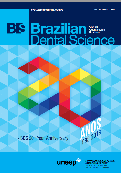Sensitivity and specificity of different indexes used to diagnose Temporomandibular Disorders
DOI:
https://doi.org/10.14295/bds.2018.v21i4.1614Resumo
Objective: To verify the level of agreement among different indexes used to achieve the prevalence of Temporomandibular Disorders (TMD). Material and Methods: One hundred one dental students were selected by a randomized process. TMD were evaluated by the Fonseca’s Anamnestic Index (FAI), Helkimo’s Clinical Index (HCI), and the Research Diagnostic Criteria for TMD (RDC/TMD). Data was analyzed using Chi-square and Kappa tests, considering a significance level of 5%. Results: HCI showed the highest prevalence of TMD, and the comparison between RDC/TMD, FAI, and HCI showed low agreement (k=0.17 and k=0.35 respectively). Most individuals presented mild TMD for both FAI and HCI indexes. A moderate correlation for TMD severity was obtained (kw=0.53) between FAI and HCI, and a high sensitivity and low specificity were observed for both diagnosis when compared to RDC/TMD. Conclusion: The prevalence of TMD may vary significantly depending on the index used for its diagnosis, which may lead to a large number of false positives and overtreatments.
Keywords: Epidemiology; Prevalence; Temporomandibular joint; Temporomandibular joint disorders; Young adult.
Downloads
Downloads
Arquivos adicionais
Publicado
Como Citar
Edição
Seção
Licença
TRANSFERÊNCIA DE DIREITOS AUTORAIS E DECLARAÇÃO DE RESPONSABILIDADE
Toda a propriedade de direitos autorais do artigo "____________________________________________________________________" é transferido do autor(es) para a CIÊNCIA ODONTOLÓGICA BRASILEIRA, no caso do trabalho ser publicado. O artigo não foi publicado em outro lugar e não foi submetido simultaneamente para publicação em outra revista.
Vimos por meio deste, atestar que trabalho é original e não apresenta dados manipulados, fraude ou plágio. Fizemos contribuição científica significativa para o estudo e estamos cientes dos dados apresentados e de acordo com a versão final do artigo. Assumimos total responsabilidade pelos aspectos éticos do estudo.
Este texto deve ser impresso e assinado por todos os autores. A versão digitalizada deverá ser apresentada como arquivo suplementar durante o processo de submissão.




























